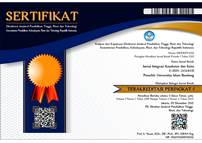Pengaruh Fraksi Air Buah Lemon (Citrus limon) terhadap Kadar Glukosa Darah Mencit Tua yang Diberi Pakan Tinggi Lemak
Abstract
Diabetes melitus merupakan salah satu penyakit yang menjadi masalah terbesar pada abad 21. Obesitas (terutama obesitas viseral) dan resistensi insulin sering disertai dengan sekelompok kelainan yang disebut sindrom metabolik yang mencakup intoleransi glukosa, trigliserida tinggi, kolesterol HDL rendah, dan hipertensi. Lemon mengandung flavonoid yang dipercaya mempunyai aktivitas menurunkan kadar glukosa darah. Tujuan penelitian ini mengetahui perubahan kadar glukosa darah pada mencit tua yang diberi pakan tinggi lemak setelah pemberian fraksi air buah lemon (Citrus limon). Penelitian dilakukan di Laboratorium Hewan Gedung Farmasi ITB dan Laboratorium Hewan Fakultas Kedokteran Universitas Islam Bandung pada bulan April−Juni 2018. Metode penelitian ini adalah eksperimental laboratorium murni in vivo dengan desain penelitian rancangan acak lengkap terhadap 28 mencit tua jantan galur DDY yang terbagi dalam lima kelompok, yakni kontrol normal, kontrol negatif, konsentrasi 20,6 mg/20 gBB, 41,2 mg/20 gBB, dan 82,4 mg/20 gBB. Pengukuran glukosa darah puasa dilakukan setelah masa adaptasi, saat perlakuan (hari ke-15), dan setelah perlakuan menggunakan glukosameter. Analisis data menggunakan Uji Kruskall-Wallis dan Uji Friedman. Hasil penelitian menunjukkan perbedaan median GDP1 antarkelompok yang signifikan (p=0,05), perbedaan median GDP2 yang tidak signifikan (p=0,08), dan perbedaan median GDP3 yang tidak signifikan (p=0,66). Terdapat perbedaan median GDP1−3 yang signifikan antara kelompok konsentrasi fraksi air buah lemon (p=0,04). Simpulan, fraksi air buah lemon memiliki efek menurunkan glukosa darah.
EFFECT OF WATER FRACTION OF LEMON (CITRUS LIMON) ON BLOOD GLUCOSE LEVEL OF OLD MICE GIVEN HIGH-FAT DIET
Diabetes mellitus is one of the biggest problems of the 21st century. Obesity (especially visceral obesity) and insulin resistance often present with a group of disorders commonly called metabolic syndrome including glucose intolerance, high triglycerides, low HDL cholesterol, and hypertension. Flavonoid compounds in lemon is believed to have blood glucose lowering activity. The purpose of this study was to determine changes in blood glucose level in old mice given a high-fat diet after administration of water fraction of lemon (Citrus limon). This study was held at Animal Laboratory of Pharmacy ITB and Animal Laboratory of Faculty of Medicine Bandung Islamic University in April to June 2018. The method of this study was pure in vivo laboratory experiment with a completely randomized design to 28 old male DDY strain mices divided into five groups; normal control, negative control, concentration 20.6 mg/20 gBW, 41.2 mg/20 gBW, and 82.4 mg/20 gBW. Fasting blood glucose measurements were performed after adaptation, ongoing treatment (day 15), and after treatment using glucosemeter. Data analysis used Kruskall-Wallis test and Friedman test. The results showed that there was a significant GDP1 median difference of each groups (p=0.05), a nonsignificant GDP2 median difference (p=0.08), and GDP3 median difference were not significantly different (p=0.66). There was a statistically significant difference between median GDP1−3 between each water fraction of lemon concentration groups (p=0.04). Conclusion, the water fraction of lemon has the effect of lowering blood glucose.
Keywords
Full Text:
PDFReferences
Cho NH, Whiting D, Forouhi N, Guariguata L, Hambleton I, Li R, dkk. IDF diabetes atlas. Edisi ke-7. Brussels: International Diabetes Federation; 2015.
Pradhan A. Obesity, metabolic syndrome, and type 2 diabetes: inflammatory basis of glucose metabolic disorders. Nutr Rev. 2008;65(12):152–6.
McCance KL, Huether SE. Pathophysiology: the biologic basis for disease in adults and children. Edisi ke-7. St.Louis: Mosby; 2014.
Marques C, Meireles M, Norberto S. High-fat diet-induced obesity rat model. Adipocyte. 2016;5(1):11–21.
Yulianti AB, Widayanti, Rahmawaty I. Efek proteksi campuran ekstrak bawang putih, jahe gajah, dan lemon terhadap kadar kolesterol total darah pada tikus tua yang terpapar diet tinggi lemak. Prosiding SNaPP2017 Kesehatan. 2017;3(1):215–21.
WHO. Traditional medicine action plan for the South-East Asia region. Geneva: WHO; 2015 [diunduh 2 Januari 2018]. Tersedia dari: http://www.searo.who.int/entity/traditional_medicine/en/.
Pathak K, Das RJ. Herbal medicine: a rational approach in health care system. Int J Herbal Med. 2013;1(3):86–9.
González-Molina E, Domínguez-Perles R, Moreno DA, García-Viguera C. Natural bioactive compounds of Citrus limon for food and health. J Pharm Biomed Anal. 2010;51(2):327–45.
Shen W, Xu Y, Lu YH. Inhibitory effects of citrus flavonoids on starch digestion and antihyperglycemic effects in hepG2 cells. 2012 Sept 8;60(38):9609–19.
Buettner R, Scholmerich J, Bollheimer LC. High-fat diets: modelling the metabolic disorders of human obesity in rodents. Obesity. 2008;15(4):798–808.
Sarian MN, Ahmed QU, So’ad SZ, Alhassan AM, Murugesu S, Perumal V, dkk. Antioxidant and antidiabetic effects of flavonoids: a structure-activity relationship based study. Biomed Res Int. 2017 Nov 28:1–14.
Gato T, Horita M, Nagai H, Nagatomo A, Nishida N, Matsuura Y, dkk. Tiliroside, a glycosidic flavonoid, inhibits carbohydrate digestion and glucose absorption in the gastrointestinal tract. Mol Nutr Food Res. 2012;56(3):768–76.
Najafian M, Habibi E, Parichehreh Y, Kazem P, Bagher L. Core structure of flavonoids precursor as an antihyperglycemic and antihyperlipidemic agent: an in vivo study in rats. Acta Biochimica Polonica. 2010;57(4):553–60.
Ellenbroek JH, Töns HA, de Graaf N, Loomans CJ, Engelse MA, Vrolijk H, dkk. Topologically heterogeneous beta cell adaptation in response to high-fat diet in mice. PLoS ONE. 2013;8(2):562–9.
DOI: https://doi.org/10.29313/jiks.v1i1.4322
Refbacks
- There are currently no refbacks.
Jurnal Integrasi Kesehatan dan Sains is licensed under a Creative Commons Attribution-NonCommercial-ShareAlike 4.0 International License.







.png)
_(1).png)




















